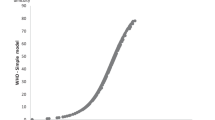Abstract
The World Health Organization Disability Assessment Scale (WHODAS) is suggested as a measure of impairment in DSM-5. The measurement of impaired functioning is crucial in the rehabilitation of dually diagnosed, addiction and mental health, patients. This study is the first to look at the use of the 12 item self report WHODAS as the primary outcome in a community correctional treatment facility for dually diagnosed patients.100 (55 male; 73 white, 25 black, 2 hispanic) former inmates, age 36.1 ± 11.1, with psychiatric and addiction diagnoses were treated in an integrated program. The 12 item WHODAS was completed by the patients during the initial evaluation and repeated an average of 11.1 ± 2.7 weeks later. The Clinical Global Impression-Severity Scale (CGI) was completed at the same time by the psychiatrist, independently of the WHODAS. At initial assessment, the CGI showed moderate severity and the WHODAS showed severe disability. CGI and WHODAS were significantly correlated (R 0.48, p < 0.0001). After three months of treatment, both measures improved: CGI with 46 % and WHODAS with 49 %. The CGI showed mild severity and the WHODAS moderate disability. The change in CGI was correlated with the change in WHODAS (R 0.57, p < 0.0001). The WHODAS appears sensitive to clinical improvement related to shortterm treatment of a highly co-morbid dual diagnosis population.
Similar content being viewed by others
References
James DJ, Glaze LE: Mental health problems of prison and jail inmates. Bureau of Justice Statistics, 2006 (http://www.ojp.usdoj.gov/bjs/mhppji.htm).
Schnittker J, Massoglia, M, Uggen C. Out and down: Incarceration and psychiatric disorder. J Health Social Beh. 2012; 53: 448-464.
Alexander MJ, Haugland G, Lin SP, et al. Mental health screening in addiction, corrections and social service setting: validating the MMS. Int J Ment Health Addiction. 2008; 6: 105-119.
Lowenkamp CT, Latessa EJ, Smith P. Does correctional program quality really matter? The impact of adhering to the principles of effective intervention 2006. Crime and Public Policy. 2006; 5: 201-220.
Moggi F, Ouimette PC, Finney JW. Effectiveness of treatment of substance abuse and dependence for dual diagnosis patients: a model of treatment factors associated with one-year outcomes. J. Stud. Alcohol. 1999; 60: 856-866.
Jones ER. Crossing the field’s quality chasm. Behav Healthc. 2006; 26: 23-24.
Tiet QQ, Mausbach B. Treatments for patients with dual diagnosis: A review. Alcoholism: Clinical and Experimental Research. 2007; 31: 1-24.
American Psychiatric Association: Diagnostic and Statistical manual of Mental Disorders, 2013.
Garin O, Ayuso-Mateos JL, Almansa J, et al. Validation of the “World Health Organization Disability Assessment Schedule, WHODAS-2″ in patients with chronic diseases. Health and Quality of Life Outcomes. 2010; 8: 51-58.
Andrews G, Kemp A, Sunderland M, et al. Normative data for the 12 item WHO Disability Assessment Schedule 2.0. PLoS ONE. 2009; 4: e8343.
Guy W. ECDEU Assessment Manual for Psychopharmacology–Revised (DHEW Publ No ADM 76-338). NIMH Psychopharmacology Research Branch. 1976; 218–222.
Tiffany ST, Friedman L, Greenfield SF, et al. Beyond drug use: a systematic consideration of other outcomes in evaluations of treatments for substance use disorders. Addiction. 2012; 107: 709-718.
George P, Whelan G, Ait Khelifa N. Quality of life and disability in alcohol and drug dependent patients undergoing treatment at Depaul House. IeJSME. 2007; 1: 35-40.
Chwastiak LA, Von Korff M. Disability in depression and back pain: Evaluation of the World Health Organization Disability Assessment Schedule (WHODAS II) in a primary care setting. J. Clinical Epidemiology. 2003; 56: 507-514.
McLellan AT, McKay JR, Forman R. Reconsidering the evaluation of addiction treatment: from retrospective follow-up to concurrent recovery monitoring. Addiction. 2005; 100: 447-458.
Conflict of interest
Leo Bastiaens, James Galus, and Michael Goodlin declare that they have no conflict of interest.
Ethical Standards
‘All procedures followed were in accordance with the ethical standards of the responsible committee on human experimentation (institutional and national) and with the Helsinki Declaration of 1975, as revised in 2000 (5). Informed consent was obtained from all patients for being included in the study.’
Author information
Authors and Affiliations
Corresponding author
Rights and permissions
About this article
Cite this article
Bastiaens, L., Galus, J. & Goodlin, M. The 12 Item W.H.O.D.A.S. as Primary Self Report Outcome Measure in a Correctional Community Treatment Center for Dually Diagnosed Patients. Psychiatr Q 86, 219–224 (2015). https://doi.org/10.1007/s11126-014-9322-6
Published:
Issue Date:
DOI: https://doi.org/10.1007/s11126-014-9322-6



